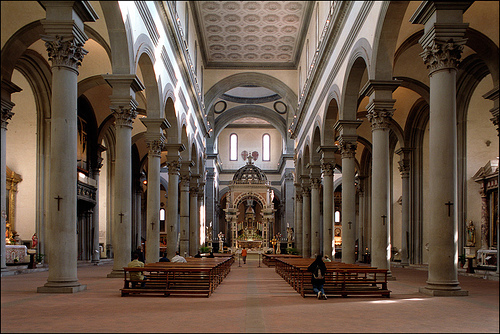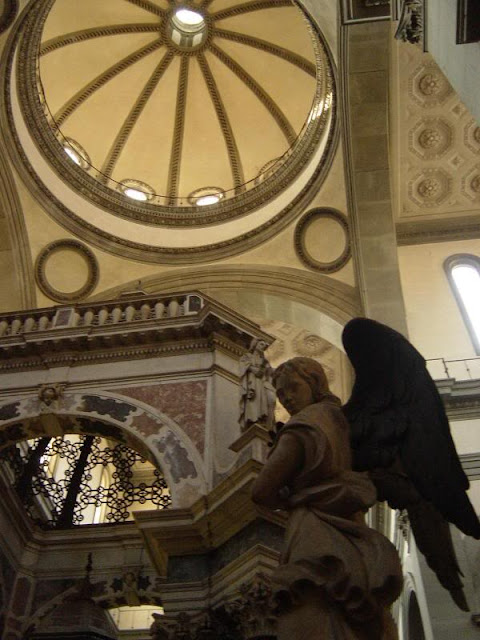Main façade.
The Basilica of Santa Maria del Santo Spirito ("St. Mary of the Holy Spirit") is a church in Florence, Italy. Usually referred to simply as Santo Spirito, it is located in the Oltrarno quarter, facing the square with the same name. The building on the interior is one of the pre-eminent examples of Renaissance architecture.
Interior of the basilica.
History
The current church was constructed over the pre-existing ruins of an Augustinian convent from the 13th century, destroyed by a fire. Filippo Brunelleschi began designs for the new building as early as 1428. After his death in 1446, the works were carried on by his followers Antonio Manetti, Giovanni da Gaiole, and Salvi d'Andrea; the latter was also responsible for the construction of the cupola.
Inside view.
Unlike S. Lorenzo, where Brunelleschi’s ideas were thwarted, here, his ideas were carried through with some degree of fidelity, at least in the ground plan and up to the level of the arcades. The Latin cross plan is so designed to maximize the legibility of the grid. The contrast between nave and transept that caused such difficulty at S. Lorenzo was here also avoided. The side chapels, in the form of niches all the same size (forty in all), run along the entire perimeter of the space.
Michelangelo's Crucifix.
Brunelleschi's facade was never built and left blank. In 1489, a columned vestibule and octagonal sacristy, designed by Simone del Pollaiolo, known as Il Cronaca, and Giuliano da Sangallo respectively, were built to the left of the building. A door was opened up in a chapel to make the connection to the church.
Santo Spirito's Cenacolo.
A Baroque baldachin with polychrome marbles was added by Giovanni Battista Caccini and Gherardo Silvani over the high altar, in 1601. The church remained undecorated until the 18th century, when the walls were plastered. The inner façade is by Salvi d'Andrea, and has still the original glass window with the Pentecost designed by Pietro Perugino. The bell tower (1503) was designed by Baccio d'Agnolo.
The exterior of the building was restored in 1977-78.
Chapel frescoes
Inside view.The church has 38 side chapels (two chapels having been given over to doors), which contain a noteworthy amount of artworks. The most significant is the Bini-Capponi Chapel, housing the St. Monica Establishing the Rule of the Augustinian Nuns painting by Francesco Botticini. The Corbinelli chapels works are by Andrea Sansovino, Cosimo Rosselli and Donnino and Agnolo del Mazziere.
In the chapels of the transept are frescoes by Filippino Lippi. Also in the transept is a choir from which the Frescobaldi Marquisses could participate to the rites without being seen by the crowd.
The sacristy, accessed through a doorway in what would have been the left sixth chapel preceded by a monumental vestibule by Simone del Pollaiolo, was designed by Giuliano da Sangallo in 1489, and has an octagonal plan. It is home to a devotional painting of St. Fiacre curing the Sick (1597) by Alessandro Allori (1596) commissioned by Christine of Lorraine, Grand Duke Ferdinando I de' Medici's wife.
Michelangelo's Crucifix
Michelangelo Buonarroti when he was seventeen years old could make anatomical studies on the corpses coming from the convent's hospital; in exchange, he sculpted a wooden crucifix which was placed over the high altar. Today the crucifix is in the octagonal sacristy that can be reached from the left, west aisle of the church.
The cloisters and the Cenacolo
The convent had two cloisters, called Chiostro dei Morti and Chiostro Grande ("Cloister of the Dead" and "Grand Cloister"). The first takes its name from the great number of tombstone decorating its walls, and was built around 1600 by Alfonso Parigi. The latter was constructed in 1564-1569 by Bartolomeo Ammannati in a classicistic style.
The former convent also contains the great refectory (Cenacolo di Santo Spirito) with a large fresco portraying the Crucifixion over a fragmentary Last Supper, both attributed to Andrea Orcagna (1360–1365). It is one of the rare examples of Late Gothic Art which can still be seen in Florence. The room also boasts a collection of sculptures from the 11th-15th centuries, including two low reliefs by Donatello, a high relief by Jacopo della Quercia (Madonna with Child) and two marble sculptures by Tino da Camaino (1320–1322).
 22:09
22:09
 homesweethome
homesweethome















 Posted in:
Posted in: 








0 意見:
Post a Comment